| |
16:00
 |
1010.
 |
Multi-Dimensional Reduced Field-of-View Excitation by Integrated
RF Pulse and DYNAMITE B0 Field Design 
Suryanarayana Umesh Rudrapatna1, Robin de Graaf1,
Terrance Nixon1, and Christoph Juchem1
1Yale University, New Haven, CT, United States
Spatially selective multi-dimensional excitation with large
flip angles is challenging, as current RF pulse design
methods are computationally involved and typically yield low
time-bandwidth product (TB < 10) pulses. The difficulty
stems from Bloch equation non-linearity and the
inflexibility in B0 pattern
generation using linear gradients. This study uses the
dynamic multi-coil technique (DYNAMITE), that provides
unprecedented B0 shaping
flexibility, facilitating the use of 1-dimensional Shinnar-Le
Roux (SLR) pulses for 2-dimensional excitation. Selective
mouse brain excitation was accomplished by adaptively
designing the SLR pulse and the underlying B0 fields
generated by DYNAMITE. The resultant zoomed MRI achieved
more than two-fold acquisition acceleration at < 4%
undesired excitation with TB > 12 pulses.
|
| |
16:12
|
1011.
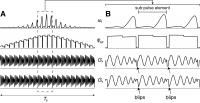 |
Designing 2D and 3D selective adiabatic pulses 
Albert Jang1,2 and
Michael Garwood1
1Center for Magnetic Resonance Research and
Department of Radiology, University of Minnesota,
Minneapolis, MN, United States, 2Department
of Electrical and Computer Engineering, University of
Minnesota, Minneapolis, MN, United States
Two-dimensional (2D) adiabatic pulses based on sampling k-space
have previously been developed using amplitude modulation in
one orthogonal direction and frequency modulation in the
other2. Here, a new method for designing two and
three-dimensional adiabatic pulses using a sub-pulse
approach is introduced. Namely, a parent adiabatic pulse is
divided into sub-pulse elements, each of which is a 2D
selective pulse. Using this approach, selective excitation
is achieved through the 2D pulse while being adiabatically
driven by the parent adiabatic pulse. This can be extended
to three-dimensions by applying blips along the remaining
direction between sub-pulses. Simulation and experimental
results are presented, confirming the validity of this
approach.
|
| |
16:24
|
1012.
 |
Tailored Spiral In-Out Spectral-Spatial Saturation Pulses for
Short and Effective Water Suppression in High Resolution MRSI 
Jun Ma1, Carrie Wismans2, Zhipeng Cao1,
Dennis W. J. Klomp2, Jannie P. Wijnen2,
and William A. Grissom1,3
1Vanderbilt University Institute of Imaging
Science, Nashville, TN, United States, 2Department
of Radiology, University Medical Centre Utrecht, Utrecht,
Netherlands, 3Biomedical
Engineering, Vanderbilt University, Nashville, TN, United
States
At ultra-high field (7T and above), the increased SNR can be
used to significantly improve MRSI spatial resolution, but
scan time is a challenge with large acquisition matrixes, so
time-efficient water signal suppression is critical.
However, at ultra-high field, B1+ and
B0 inhomogeneities degrade the performance of time-efficient
CHESS water suppression strategies. To address this, we
propose to replace conventional spectrally-selective pulses
with subject-tailored spiral in-out spectral-spatial (SPSP)
saturation pulses that are designed using subject-specific
B1+ and
B0 maps. The pulses were validated in in vivo experiments.
|
| |
16:36
|
1013.
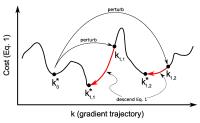 |
Improved gradient waveforms for small-tip 3D spatially tailored
excitation using Iterated Local Search 
Jon-Fredrik Nielsen1, Hao Sun2,
Jeffrey A Fessler1,2, and Douglas C Noll1
1Biomedical Engineering, University of Michigan,
Ann Arbor, MI, United States, 2Electrical
Engineering and Computer Science, University of Michigan,
Ann Arbor, MI, United States
We propose a strategy for the joint design of gradient and
radiofrequency waveforms for small-tip 3D spatially tailored
excitation, that may lead to more globally optimal
excitation k-space trajectories. Currently, gradients are
either pre-defined or restricted to certain classes such as
echo-planar or concentric shells. Our method makes use of a
recently proposed optimization method that expresses k-space
with a 2nd-order B-spline basis permitting arbitrary k-space
trajectories. We employ this method in an Iterated Local
Search strategy, and show that this approach reduces the
sensitivity of the excited pattern to the choice of initial
k-space trajectory that "seeds" the optimization.
|
| |
16:48
 |
1014.
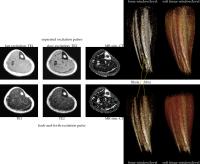 |
Short-T2 specific excitation by a 'back-and-forth' composite RF
pulse 
Ethan M Johnson1, Adam B Kerr1, Kim
Butts Pauly2, and John M Pauly1
1Electrical Engineering, Stanford University,
Stanford, CA, United States, 2Radiology,
Stanford University, Stanford, CA, United States
Images of cortical bone have previously been created by
selection of RF pulse parameters giving
short-$$$T_2$$$-specificity in excitation for a 3D UTE
sequence. The previous demonstration required multiple
excitations. Here a composite pulse is described that
creates similar contrast for depicting cortical bone with
bright signal.
|
| |
17:00
 |
1015.
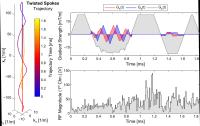 |
B0-robust slice-selective excitations for ultra-high field with
flip-angle mitigation using parallel transmission 
Mathias Davids1,2, Bastien Guérin2,3,
Lawrence L Wald2,3,4, and Lothar R Schad1
1Computer Assisted Clinical Medicine, Medical
Faculty Mannheim, Heidelberg University, Mannheim, Germany, 2A.
A. Martinos Center for Biomedical Imaging, Department of
Radiology, Massachusetts General Hospital, Charlestown, MA,
United States, 3Harvard
Medical School, Boston, MA, United States, 4Harvard-MIT,
Division of Health Sciences and Technology, Cambridge, MA,
United States
High field MRI suffers from non-uniform transmit fields and
B0 variations
due to increased susceptibility effects, making uniform
slice-excitation very difficult. We developed a new pulse
trajectory – the “twisted spokes” RF pulse – to achieve
accurate slice-selection with high in-plane uniformity and
greatly improved B0 robustness.
The twisted spokes trajectory consists of helical k-space
segments oriented along the slice-selection direction (e.g.,
kz). We found that, when the helical segments are
designed appropriately, the resulting RF pulses are short,
achieve sharp slice profiles and uniform flip-angle
distributions, and – at the same time – are very robust to
off-resonance effects.
|
| |
17:12
 |
1016.
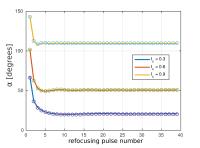 |
Optimal Control Design of Turbo Spin-Echo Sequences with
Applications to Parallel-Transmit Systems 
Alessandro Sbrizzi1, Hans Hoogduin1,
Joseph V Hajnal2, Cornelis AT van den Berg1,
Peter R Luijten1, and Shaihan Malik2
1UMC Utrecht, Utrecht, Netherlands, 2King's
College London, London, United Kingdom
We cast the design of variable refocusing angles in TSE
sequences as an optimal control problem. By application of
the Adjoint States method (ASM), we are able to design
dynamic shimming setting for pTx systems in a
patient-specific, online fashion.
|
| |
17:24
 |
1017.
 |
IMPULSE-SMS: Local SAR and peak power optimized pTx pulse design
for simultaneous multislice imaging at high fields 
Mihir Pendse1 and
Brian Rutt1
1Stanford University, Stanford, CA, United States
We describe an extension of the IMPULSE pTx design algorithm
to enable simultaneous multislice (SMS) excitation. We
introduce a strategy for integrating the optimal control
method for reducing peak power in SMS with the optimization
of pTx channel weightings. Desirable features of IMPULSE,
including the ability to optimize spoke locations and to
design pulses without SAR compression, are retained in this
extension. We demonstrate that, even for large multiband
acceleration factors, our approach enables design of pTx
pulses that minimize local SAR while achieving acceptable
in-slice homogeneity under strict peak power constraints.
|
| |
17:36
|
1018.
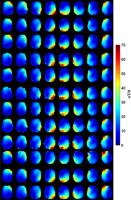 |
Universal pulses: a new concept for calibration-free parallel
transmission 
Vincent Gras1, Alexandre Vignaud1,
Alexis Amadon1, Denis Le Bihan1, and
Nicolas Boulant1
1Neurospin, CEA/DSV/I2BM, Gif-sur-Yvette, France
At ultra-high field, a drawback of parallel transmission to
mitigate the RF inhomogeneity problem is the necessity to
measure subject-specific field maps in order to return
optimized RF pulses, thereby decreasing the time available
for clinically-relevant scans. In this work, we investigate
numerically and experimentally at 7T the design of
"universal" kT-points pulses, which does not require the
aforementioned calibration step but yet considerably
improves excitation homogeneity compared to the standard
circularly-polarized and RF shim modes. Such approach can
simplify considerably the workflow of parallel transmission
and render the potential of ultra-high field scanners more
accessible to anyone in routine.
|
| |
17:48
|
1019.
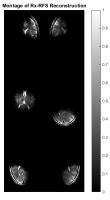 |
RF Shimming for High Field MRI using Multi-channel
Receive-Signals 
Abhinav V. Sambasivan1, Lance DelaBarre2,
Emad S. Ebbini1, Thomas J. Vaughan1,2,
and Anand Gopinath1
1Electrical and Computer Engineering, University
of Minnesota-Twin Cities, Minneapolis, MN, United States, 2Center
for Magnetic Resonance Research, UMN-Twin Cities,
Minneapolis, MN, United States
Counteracting the effects of B1 heterogeneities
has been a major challenge for High field MRI systems. We
propose here, a receiver-based approach called the Receive-RF
Shimming (Rx-RFS) algorithm for multichannel MR systems
which offers potential advantages in terms of reducing image
acquisition time and mitigating SAR concerns. RX-RFS
involves computing an optimal spatially-varying weight
vector for combining the images from different receive
elements. The reconstructed images (using Rx-RFS) exhibit
enhanced contrast and more uniform signal levels when
compared to standard reconstruction schemes throughout the
entire Field-of-View. Rx-RFS also offers clinicians the
flexibility to obtain local reconstructions at arbitrary
Regions-of-Interest.
|
|










